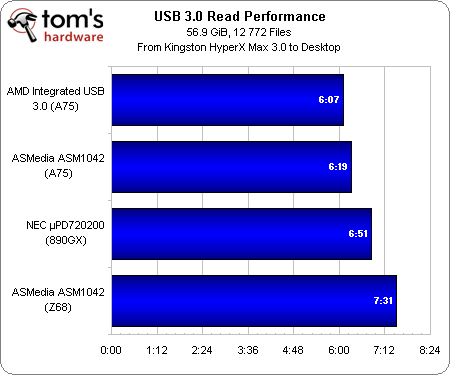AMD A8-3850 Review: Llano Rocks Entry-Level Desktops
Earlier this month we previewed AMD's Llano architecture in a notebook environment. Now we have the desktop version with a 100 W TDP. How much additional performance can the company procure with a loftier thermal ceiling and higher clocks?
Storage Performance
When it comes to storage, AMD’s A75 chipset is more advanced than anything Intel currently offers. In contrast, the A55 chipset is a disappointing step backward.
The A75 platform features six SATA 6 Gb/s ports, software-based RAID 0, 1, and 10 support, FIS-based switching, and four USB 3.0 ports. Though integrated USB 3.0 connectivity is really the only new feature, we still wanted to test the platform’s complete storage suite.
SATA 6Gb/s: A Little Better, Perhaps?
AMD doesn’t specifically cite any improvements made to its SATA 6Gb/s controller. However, we still measured slightly higher sequential write performance and better random read/write throughput using a 240 GB OCZ Vertex 3 Pro.
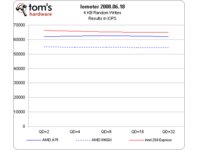
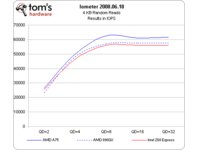
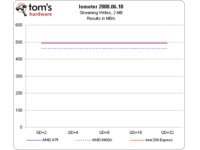
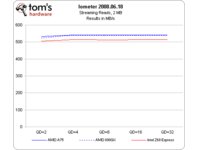
Although Intel’s controller generally comes out on top, AMD’s improvements are significant enough to yield better sequential read performance, better random read speed, and near-parity in our workstation workload.
USB 3.0: Better Than An Add-On Controller
No longer the shiny new feature it once was, USB 3.0 support is expected on an enthusiast board today, even if the number of devices designed to maximize a SuperSpeed port is still small. Nevertheless, we have a few high-performance USB 3.0-based devices in the lab, so it makes sense to see how AMD’s integrated controller measures up.
Get Tom's Hardware's best news and in-depth reviews, straight to your inbox.
Our 890GX-based motherboard, Asus’ M4A89GTD Pro/USB3, includes an NEC µPD720200 controller; our Z68-based Asus P8Z68-V Pro sports an ASMedia ASM1042 controller, and the ASRock A75 Extreme6 features the integrated AMD controller plus an additional ASM1042. We use a Kingston DataTraveler HyperX Max 3.0 to test performance. And while its 195 MB/s peak read speed doesn’t come anywhere near maxing out the interface, it’s an astounding improvement from what we’re used to from USB 2.0-based drives. Our test workload consists of 12 772 files in 621 folders occupying 56.9 GiB of capacity.
All three controllers are fast—we’re not used to moving more than 50 GiB in between six and eight minutes. However, AMD’s built-in logic finishes the task first, followed closely by the ASMedia controller on that same A75-based motherboard. The NEC controller comes in third place, while an ASMedia chip on an Intel Z68 Express-based board takes quite a while longer to finish the transfer.
Now, just because AMD’s controller is integrated doesn’t mean you get the convenience of a USB 2.0 interface. The USB 3.0 ports are completely unusable until you get drivers installed, which makes any remaining USB 2.0 ports valuable for keyboards and mice, particularly if you need to install Windows or change BIOS settings.
Current page: Storage Performance
Prev Page Chipsets Next Page Making Memory Performance Matter Again-
SteelCity1981 So then what's the point of getting the Turbo Core versions when they are going to be Turbo Clocked slower then the none Turbo Clocked versions...Reply -
cangelini SteelCity1981So then what's the point of getting the Turbo Core versions when they are going to be Turbo Clocked slower then the none Turbo Clocked versions...Reply
They don't want you to see better performance from a cheaper APU in single-threaded apps by pushing Turbo Core further ;-) -
Known2Bone i really wanted see some amazing gains in the content creation department what with all that gpu power on chip... oh well games are fun too!Reply -
ivan_chess I think this would be good for a young kid's PC. It would be enough to run educational software and a web browser. When he grows up to be a gamer it would be time to replace the whole machine anyway.Reply -
DjEaZy ... it's may be not the greatest APU for desktop... but it will be a powerful thingy in a laptop... the review was nice... but in the gaming department... would be nice to see a standard 15,x'' laptop resolution tests @ 1366x768... or something like that...Reply -
Mathos Actually if you want good DDR3 1600 with aggressive timings, the Ripjaws X series memory that I have does DDR3 1600 at 7-8-7-24 at 1.5v, not all that expensive when it comes down to it either.Reply -
Stardude82 This makes little sense. An Athlon II X3 445 ($75) and a HD 5570 ($60, on a good day you can get a 5670 for the same price) would provide better performance for the same price ($135) and not have to worry about the RAM you use.Reply
So is AM3+ going to be retired in favor of FM1 in the near future? Why are there chipset at all? Why isn't everything SOC by now?
Otherwise this is a very good CPU. If AMD has used 1 MB level 2 caches in their quads when they came out with the Deneb Propus die, they would be much more competitive. -
crisan_tiberiu stardude82This makes little sense. An Athlon II X3 445 ($75) and a HD 5570 ($60, on a good day you can get a 5670 for the same price) would provide better performance for the same price ($135) and not have to worry about the RAM you use. what about power consumption?Reply

